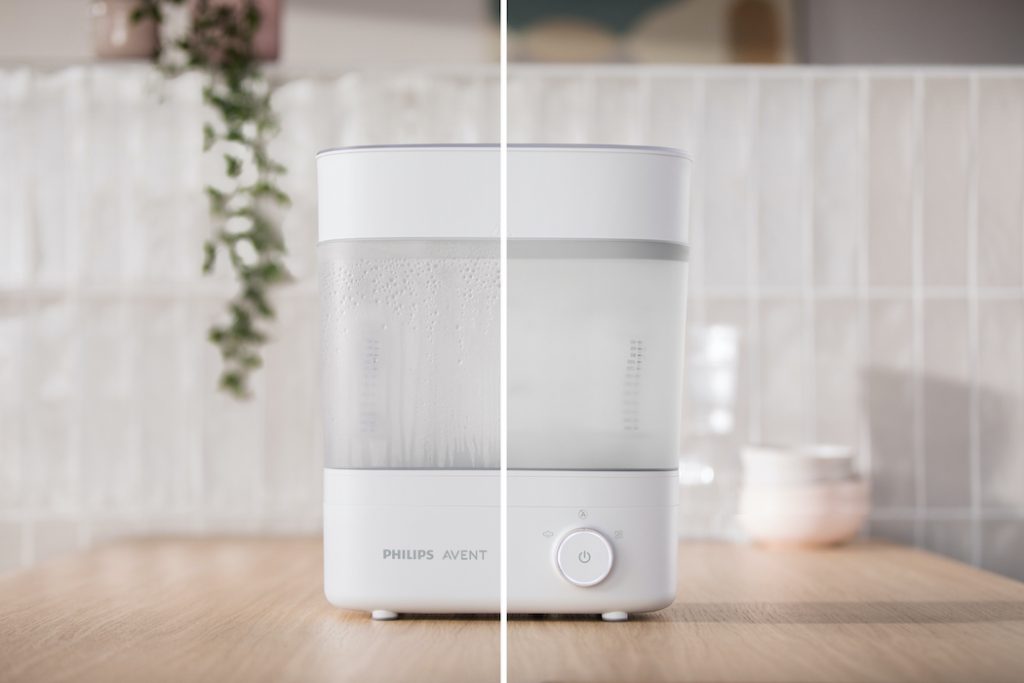So you’ve purchased all of your baby’s feeding utensils. Congratulations mummy, you’re all set!
Or are you really?
Did you know that newborns and infants have under-developed immune systems and need to drink from clean feeding equipment?
For the first few months of life, a baby is vulnerable to infections by viruses, bacteria, parasites and fungi, which can all lead to unwanted illnesses. Germs are likely to grow quickly if breast milk or formula is added to a bottle that hasn’t been cleaned well. Hence, sterilising your baby’s feeding equipment is crucial to ensure that your baby is protected.
But what exactly is sterilisation and how does it work?
Sterilisation refers to a process that removes, kills, or deactivates all forms of life such as viruses, bacteria, fungi and other forms of microorganism.
A widely used method to sterilise is the steam method. Compared to sterilisation with UV light, the steam method is much more common and safe in sterilising baby equipment. This is because UV light only kills germs if it directly shines on the product surface containing bacteria. Unlike steam, which is a gas and can easily spread across the entire surface of a bottle, teat pump and other baby equipment regardless of shape.

Besides that, long term sterilising with UV causes photodegradation of plastics and silicone, which can be harmful for your baby. It also means that you might need to change your baby’s bottles and teats more often than usual.
But let’s not get into too much details, what you need to know is that the basic principle of steam sterilisation, is to make sure each item is exposed to direct steam contact at the required temperature and pressure for a specified time.
Sterilising your baby’s equipment may seem like a straightforward task, but there are some important don’ts that you’d want to take note of.
5 Major Don’ts When Sterilising Your baby’s Equipment
#1 – DON’T put dirty bottles in the steriliser
Before putting your baby’s bottle, pacifier and other feeding utensils into the steriliser, it’s important to wash them in hot soapy water as soon as possible after feeding. Use a clean bottle brush or sponge that is exclusively for baby’s equipment and a small teat brush to clean the insides of teats.
Give particular attention to the caps and screw top areas – this is where bacteria are most likely to grow. Then rinse the equipment under cold running water before sterilising.
#2 – DON’T put whole bottles in without taking it apart
Once you’ve already taken your baby’s bottles apart when cleaning, there’s no need to put them back together. Place the parts in the steriliser, paying close attention that the openings of the bottles and teats are facing downwards. This ensures that the bottles and teats are thoroughly sterilised.
#3 – DON’T wipe bottles or baby equipment with a kitchen towel after sterilising
Once your baby bottles or equipment has been sterilised, it is best not to wipe them dry with a kitchen towel as you could be transferring germs and other small particles that might be in the cloth onto them. Simply just shake off excess water from the bottles or just let it air dry in the steriliser itself.
#4 – DON’T handle baby bottles or feed baby without washing your hands first
This goes without saying, especially since we’re in a pandemic, that it’s important to wash your hands with soap before handling your baby’s bottles or when you’re feeding your baby.
#5 – DON’T place equipment in the open where germs can easily contaminate
Once you’ve sterilised baby’s equipment, don’t leave it in the open – you’re just inviting more germs and bacteria to contaminate them. Instead, store equipment you aren’t going to use straight away in a clean, sealed container or leave it in the steriliser.
Philips Avent Sterilizer – Sterilize, Dry and Store

If you’re looking for a steriliser that doesn’t just sterilise, but dries and can store feeding materials while keeping it sterile for up to 24 hours, Philips Avent Sterilizer just might be your answer.
Once you’ve cleaned baby’s bottles and equipment with hot soapy water, rinse them and place it into the steriliser. Philips Avent Sterilizer has a powerful steam-sterilising function that kills 99.9% of germs and bacteria. It also has a focused jet of filtered air that will then dry the bottles and equipment after sterilising, making it ready for your baby’s next feed in just 40 minutes.

Additionally, Philips Avent Sterilizer does more than clean and dry bottles. Once the sterilising and drying cycle is complete, you can just store baby’s bottles and equipment in the steriliser, keeping them sterile for up to 24 hours. This means less mess around the home, and cleaner and safer bottles and accessories.
Philips Avent Sterilizer is also safe for soft plastic parts, silicone and PPSU (polyphenylsulfone) – a high temperature thermoplastic material with outstanding impact resistance.
To purchase or to find out more information about the Philips Avent Sterilizer, click here.
Lily Shah
With a background of empowering women through talkshows on all thing Womanhood, it was natural for Lily to start empowering women on one of the biggest role they carry (a mother) after having one of her own. As a millennial mum with 2 young boys herself, she understands what new parents are going through and seeks to empower, inspire and ease parents on their biggest adventure yet- Parenthood!














